Lea Wait's Blog, page 52
November 3, 2023
Weekend Update: November 4-5, 2023
 Next week at Maine Crime Writers there will be posts by Brenda Buchanan (Monday), Jule Selbo (Tuesday), Joe Souza (Thursday) and Vaughn Hardacker (Friday).
Next week at Maine Crime Writers there will be posts by Brenda Buchanan (Monday), Jule Selbo (Tuesday), Joe Souza (Thursday) and Vaughn Hardacker (Friday).
In the news department, here’s what’s happening with some of us who blog regularly at Maine Crime Writers:
Recently, a bunch of us did a Noir at the Bar reading in Portsmouth, NH. Great time had by all. Here are some photos of the event:




On November 15th, a group of us will be doing a virtual book launch for our friend Clea Simon courtesy of Harvard Bookstore. Here’s the info:

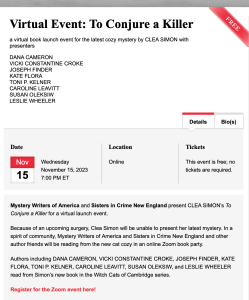
Matt Cost will be the featured author at a writing workshop at the Merry Barn in Edgecomb on Thursday, November 9th, from 5:30 to 8:00 p.m. Come listen to him read from his work in progress, Mainely Mayhem, as well as others from the audience testing out their work.
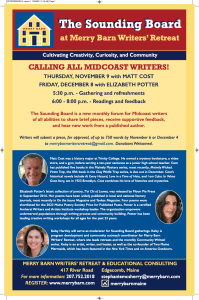
An invitation to readers of this blog: Do you have news relating to Maine, Crime, or Writing? We’d love to hear from you. Just comment below to share.
And a reminder: If your library, school, or organization is looking for a speaker, we are often available to talk about the writing process, research, where we get our ideas, and other mysteries of the business, along with the very popular “Making a Mystery” with audience participation, and “Casting Call: How We Staff Our Mysteries.” We also do programs on Zoom. Contact Kate Flora
November 2, 2023
NANOWRIMO Revisited or Why Aren’t You Writing?
This post appeared several years ago. As I, and many, many others, are trying again this November, I am reposting it with a few updates. Haven’t tried it yet? Why not this year? It’s fun!
 Kate Flora: Permission to suck? A pretty provocative statement, yes? But an important one. Because in November, writers everywhere are trying to write 50,000 words in a month. This means facing perhaps the greatest writer’s challenge of all: turning off the critical head on your shoulder that is constantly criticizing, correcting, and getting in the way, and just letting the story rip no matter what. No matter how crazy it gets. No matter how far your characters stray from what you’ve planned. No matter that the story veers away from what you envisioned and heads in new and different directions. Whatever wants to happen, just go with it.
Kate Flora: Permission to suck? A pretty provocative statement, yes? But an important one. Because in November, writers everywhere are trying to write 50,000 words in a month. This means facing perhaps the greatest writer’s challenge of all: turning off the critical head on your shoulder that is constantly criticizing, correcting, and getting in the way, and just letting the story rip no matter what. No matter how crazy it gets. No matter how far your characters stray from what you’ve planned. No matter that the story veers away from what you envisioned and heads in new and different directions. Whatever wants to happen, just go with it.
No one is looking.
In case there is a soul somewhere on the planet who doesn’t know, NaNoWriMo stands for National Novel Writers Month. Every November, writers sign up to write a 50,000 word novel during the month. Signing up means you’ll probably be put into a group where you can go to meetings if you want that for support, and you will be able to log in to chart your word counts and your progress, and get encouraging e-mails throughout the month.
Sisters in Crime sistersincrime.org is offering a month of advice and daily write-ins for writers who need the support of a group, or the structure and fun of writing with a group.

Tips for NaNoWriMo
The internet is absolutely full of advice about how to prep for NaNoWriMo, how to do  NaNoWriMo. So much advice, in short, that you could probably write a novel using the tips as prompts or just aggregate the advice into a short book. Or is that aggravate? Because with so much advice out there, it can be aggravating. Confusing. Overwhelming. And pretty often, those who are offering the advice are quite certain that they are right.
NaNoWriMo. So much advice, in short, that you could probably write a novel using the tips as prompts or just aggregate the advice into a short book. Or is that aggravate? Because with so much advice out there, it can be aggravating. Confusing. Overwhelming. And pretty often, those who are offering the advice are quite certain that they are right.
Should you outline in advance? Have the plot of the work all sketched out? Perhaps have it all storyboarded and taped to your office wall?
The possibilities are endless. And the bottom line, in my opinion, depends entirely on what kind of a writer you are. Or, if this is an early foray into the world of writing, what kind of person you otherwise are. Do you like to do a lot of prepping or do you like sail into an adventure and wing it and see what life brings?
On your behalf, I went out and waded through a bunch of those advicely blogs. And like a retriever, I have brought back the wisdom that speaks to me. You can snap up my thoughts and make them your own, or go atrolling for yourself.
 So here, in no particular order, are the bits of advice that I think are most useful if you are going to have fun with NaNoWriMo.
So here, in no particular order, are the bits of advice that I think are most useful if you are going to have fun with NaNoWriMo.
Embrace a new mindset.
Answer “YES!”
Just start and keep going.
Silence your editor, that picky little voice that tells you you’re doing it wrong. If necessary, draw a picture of your editor and stick pins in it. Be silly if you need to be. This is your adventure. Own it.
Write fearlessly.
Write “TK” for missing facts. Don’t stop to look things up. Don’t obsess over what you can’t remember. You can fix all that later.
Embrace Anne Lamott’s advice: it’s okay to write a shitty first draft. You can edit a draft and make it better. You can’t edit a blank page.
Embrace the word discipline.
For once, elevate quantity above quality. Don’t edit. Just keep going. Do keep track of your word count. It’s part of the game.
Keep telling yourself: The Perfect is the Enemy of the Good
Remember that you’re not trying to win, you’re trying to be
Don’t let the risk of obsession scare you off
You have permission to suck. Who cares. You may make amazing discoveries in the process.
Unplug. No phone calls. No checking e-mail. No selfies.
Exception: You can make yourself, or your story, or your protagonist, a playlist. It can become part of the ritual.
Write in the same place if you can, because the ritual of place can become part of the ritual of writing.
Finally, a bit of heretical advice. The rules say you’re supposed to write something new. But you are writing for you, not for them. If you’ve got the half-finished story in the drawer you’ve never had time to get back to…you are allowed to take it out and finish it. (Don’t tell them I said this.) If you’ve been stuck in a novel for years, maybe this is your chance to finish it.
November. Your month. You’re the writer. The only thing you have to do is honor your desire to write by giving it the time it deserves. And see where story takes you.
A lot of advice is about prepping…but hey, you’re out of time, and about not bothering agents or editors with your unedited glop at the end. But you wouldn’t do that anyway.
Here are a couple of blogs I used to compile the above.
http://terribleminds.com/ramble/2011/10/04/25-things-you-should-know-about-nanowrimo/
November 1, 2023
Stephen Steenrod, Veteran
Kaitlyn Dunnett/Kathy Lynn Emerson here, once again deeply engrossed in genealogical research. Veterans’ Day isn’t until next week, but this is my day to blog, so here, in honor of all veterans, I offer the story of a veteran of the War of 1812.

the Battle of Ft. George
Stephen Steenrod, my great-great-grandfather, was born August 19, 1789 in Delaware County, New York. By his affidavit of January 16, 1849, as a resident of Hancock, Dutchess County, New York, he described his service in the War of 1812. He enlisted for an eighteen-month term on July 16, 1812. The company was commanded by Captain Henry Leavenworth and Lieutenant Murdoch, part of the 25th Regiment under Colonel Cutting. It was organized in Delhi, New York, whence they marched to Greenbush, New York, thence to Whitehall, New York, and later to Champlain, Canada. There Stephen was exposed to snow and “other inclemencies [sic] of weather,” often without a tent. Even when he had a tent, he had to sleep on the ground.

The Battle of Stoney Creek by Charles Jeffreys
From Champlain he was sent to Plattsburgh, New York, where he spent two or three weeks on the lake shore “exposed to storms and suffering privations before the barracks were finished.” On or about January10, 1813, before the completion of the barracks, he was “taken sick by unavoidable exposure while on duty.” Apparently his legs were frost-bitten and so badly swollen that he was conveyed to a hospital. There his legs were cut open in several places to drain and his health “became very much impaired.” Despite still being in the hospital when the encampment broke up, he stayed in the Army as a corporal on light duty and was sent to Sacketts Harbor “and all the general routes on the frontier.” He was at the Battle of Fort George (May 27, 1813), which the Americans won and thereafter used as a base of operations to invade the rest of Upper Canada. He was also at the Battle of Stoney Creek (June 6, 1813), a loss to the British, the Battle of Cornwall (November 11, 1813; also known as the Battle of Crysler’s Farm), and several skirmishes. When his term of service expired in January 1814, he was honorably discharged at French Mills by Captain Murdoch, and paid in full to that time with an additional allowance of nineteen days’ rations to travel homeward. He arrived back in Hancock on February 14, 1814. Afterward, according to the affidavit, “the sickness and disease continued in his limbs and in his left leg so that upon favoring it, the other leg became stiff and contracted at the knee, so that he became a ‘perfect’ cripple.”

The Battle of Crysler’s Farm by Adam Sheriff Scott
Despite his condition, he married twice, first in 1815 and a second time in 1844, after his first wife’s death the previous year. He fathered eleven children.
In the 1850 census, Stephen Steenrod, age 50, farmer, owned real estate valued at $1000. In that same year, after a long delay due to the loss of his discharge papers, he was awarded a pension for disabilities suffered during his service in the war of 1812.
Happy ending? That’s unclear. In 1855, Stephen was listed as a carpenter in the New York State census. Then, in the Delaware Gazette for May 7, 1856 (and again on May 28) there appeared a notice of a sheriff’s sale of “the goods and chattels, lands and tenements of Stephen Steenrod.” These were to be sold a public auction in Hancock on Monday, June 23, 1856. The notice includes a description of the parcel of land in the town of Hancock. It contained about two hundred and fifty acres and was located on the south side of the East Branch of the Delaware river (originally part of Great Lot No. 3 in the Hardenburgh Patent). The boundaries were the East Branch of the Delaware river on the north, a small creek known as the Ellware Hollow Creek on the east, Great Lot No. 2 on the south, and Benjamin Thomas’ land on the west.
Stephen afterward moved to Freemont Center in neighboring Sullivan County, where he is found in the census of 1860. He is listed as a farmer, but the value of his real estate is only $100 and the value of his personal property is listed as $290. On October 27, 1863, still living in Fremont Center, he applied for an increase in his two-thirds pension to a full pension, declaring that he’d been totally disabled for more than eleven years. When he died on May 6, 1866, his request had not yet been granted and his widow’s claim to have his pension revert to her was not allowed. She was still living in Freemont Center in 1875.
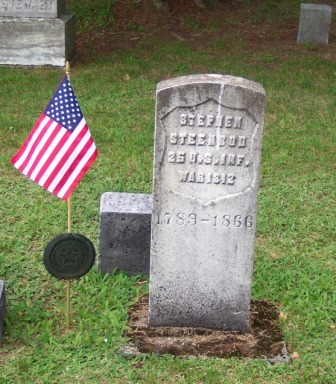
Stephen is buried in Cooks Falls Cemetery in Cooks Falls, New York, a hamlet in Delaware County that is approximately twenty miles from Hancock and about ten miles from Freemont Center. His first wife lies beside him but her marker reads only MOTHER. Stephen’s headstone honors his service as a veteran of the War of 1812.
 Kathy Lynn Emerson/Kaitlyn Dunnett has had sixty-four books traditionally published and has self published others. She won the Agatha Award and was an Anthony and Macavity finalist for best mystery nonfiction of 2008 for How to Write Killer Historical Mysteries and was an Agatha Award finalist in 2015 in the best mystery short story category. In 2023 she won the Lea Wait Award for “excellence and achievement” from the Maine Writers and Publishers Alliance. She was the Malice Domestic Guest of Honor in 2014. She is currently working on creating new omnibus e-book editions of her backlist titles. Her website is www.KathyLynnEmerson.com.
Kathy Lynn Emerson/Kaitlyn Dunnett has had sixty-four books traditionally published and has self published others. She won the Agatha Award and was an Anthony and Macavity finalist for best mystery nonfiction of 2008 for How to Write Killer Historical Mysteries and was an Agatha Award finalist in 2015 in the best mystery short story category. In 2023 she won the Lea Wait Award for “excellence and achievement” from the Maine Writers and Publishers Alliance. She was the Malice Domestic Guest of Honor in 2014. She is currently working on creating new omnibus e-book editions of her backlist titles. Her website is www.KathyLynnEmerson.com.
October 30, 2023
My Dream or Nightmare Halloween Costume
For our group post this Halloween, John Clark suggested we post about the Halloween costume we’d wear if we dared. So below, you will find some of our ideas. Do you have a dream costume? One you always wanted to wear? One you wore? One you will wear this year to answer the door? Please share with us.
Kate Flora: If I weren’t old and round and wrinkled, I would finally channel my inner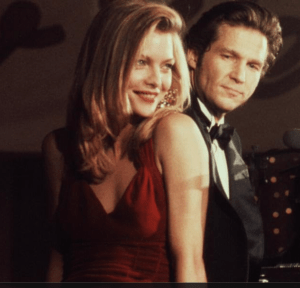 Michelle Pfeiffer in The Fabulous Baker Boys. That slinky red dress she wore as she sprawled across the piano. Maybe it’s because, like many, I’ve always had a secret desire to be a torch singer. Not very likely, since despite twelve years in the church choir I sing like a frog recovering from a cold, but a girl can dream, right?
Michelle Pfeiffer in The Fabulous Baker Boys. That slinky red dress she wore as she sprawled across the piano. Maybe it’s because, like many, I’ve always had a secret desire to be a torch singer. Not very likely, since despite twelve years in the church choir I sing like a frog recovering from a cold, but a girl can dream, right?
I’m still someone who’d like princess costumes and floor-length fancy dresses. At least once, when I got the lifetime achievement award at the New England Crime Bake, I did get a tiara. That was fun.

Me in my tiara with the fabulous Walter Mosley
John Clark: Tony Bennett has nothing on me. He might have left his heart in San Francisco, but I have him beat. I took that famous chainsaw from the slasher film, cut up my self-consciousness into a dozen pieces and sold them through Uncle Henry’s. When I was the librarian in Boothbay Harbor, I marched in a parade as a hard-boiled mystery (alas no photo is available). I do have my award winning photo when I volunteered as Maine’s Porn Czar.

And I’ve been known to channel Rocky
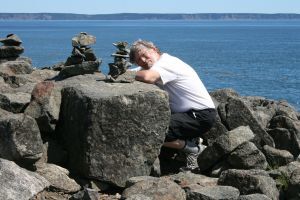
If I could go as anything this year, I’d like to go as a banned book, maybe wearing only strategically placed copies of Gender Queer and Catcher In the Rye.
Charlene D’Avanzo: This is my dream/nightmare costume which I actually wore as a kid for one of my mother’s gigs (truly).


Kaitlyn Dunnett/Kathy Lynn Emerson: The first image that came to mind was one of myself as a vampire. Then I added in the costume worn by Elvira. There are two problems that turn this dream into a nightmare. I would be able to keep the fangs in or the dress up!
Maggie Robinson: Like Kate, I’m all about the tiaras, and I actually have a gorgeous, glittering one that was given to me last year for my birthday. (This year, I got a baseball cap. Not sure of that progression, LOL.) If I were dressing up, I’d repeat a favorite outfit from a few years ago that I wore at a conference when I went to such things. I’d haul out a heavily-beaded black cocktail dress I’ve had for years and vamp it up with a 1920s headband, gloves, and a rope of pearls. I’d pretend I was a character from the Lady Adelaide series…or perhaps someone from the new Lady May books, coming in 2024!

Matt Cost has been Barbie and Tinky-Winky in years past. This year I plan to go to a Halloween Party in the EVERY-WRITER dream role of Stephen King. Maybe in the future I will go as one of the characters I’ve created. Goff Langdon. Clay Wolfe. 8 Ballo. Late thought, but interesting.



October 27, 2023
Weekend Update: October 28-29, 2023
 Next week at Maine Crime Writers there will be a group post for Halloween on Monday and posts by Kaitlyn Dunnett/Kathy Lynn Emerson (Thursday) and Kate Flora (Friday).
Next week at Maine Crime Writers there will be a group post for Halloween on Monday and posts by Kaitlyn Dunnett/Kathy Lynn Emerson (Thursday) and Kate Flora (Friday).
In the news department, here’s what’s happening with some of us who blog regularly at Maine Crime Writers:
Joseph Souza’s new psychological thriller, THE ANCHORMAN’S WIFE (Level Best Books), was published on October 24. Mystery Tribune has listed it as one of their best crime, mystery and thriller books of October.

An invitation to readers of this blog: Do you have news relating to Maine, Crime, or Writing? We’d love to hear from you. Just comment below to share.
And a reminder: If your library, school, or organization is looking for a speaker, we are often available to talk about the writing process, research, where we get our ideas, and other mysteries of the business, along with the very popular “Making a Mystery” with audience participation, and “Casting Call: How We Staff Our Mysteries.” We also do programs on Zoom. Contact Kate Flora
October 26, 2023
The Down East Game War (Part I)

Vaughn C. Hardacker
Summer has ended in Maine, and thousands of Maine sportsmen and women are taking to the woods in search of wild game. Hunting and fishing are major businesses in rural Maine, which is most of the state. The money spent on hunting licenses ($26.00 for a resident and $115.00 for a non-resident), lodging, meals, and hunting equipment brings over $200 million per year. Hunting alone is a major source of revenue for Maine businesses and state, county, and state governments.
Hunting in Maine goes back to before the state was first settled by European immigrants, reported to be 1602. Until the latter part of the 19th century, market hunting was a major source of revenue for the population of many small towns throughout the state. For many years, market hunters harvested Maine’s deer and moose and sold the saddles (The saddle is from the loin area in the lumbar region and is made up of the loin on either side of the animal. You could either buy it with the bone in or with the bone removed and rolled up into an easy-carve joint.) to brokers in towns such as Calais and Machias, who in turn shipped them to Boston.
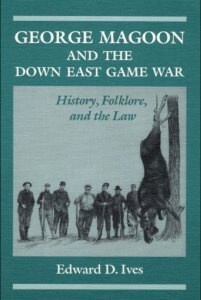
George Magoon and The Down East Game War
I attended the Maine Bookfest in Hallowell and met a man who, upon learning that I was trom THE COUNTY, told me that I should read a book entitled George Magoon and The Down East Game War. Edward D. (Stoney) Ives wrote the book, and in it, he chronicles the life and stories (both fact and myth) of one of Washington County, Maine’s most prolific poachers. Ives taught classes in folklore at the University of Maine, Orono (one of his students was no other than Stephen King), and while researching the songs sung in the hunting, fishing, and logging camps in earlier days. It was on one of his visits to an old man who was a singer he first heard of George Magoon. It was one of those defining moments that most of us had when we first developed the fire that altered the direction of our life–remember the first story you ever wrote? I do but we won’t go there… it was truly awful.
I will blog more about George Magoon in a future blog. The most eye-opening aspect of Ives’s book is the history of the beginning of Maine’s wildlife conservation laws. Prior to 1870, people living in many of Maine’s rural areas considered themselves to be farmers. Unfortunately, a great many of them soon learned that the ground was not really conducive to raising crops (similar to what is happening today in Brazil and the deforestation of the Amazon). In truth the primary function of their farm was to be a base of operations, a way of providing the basic necessities. However, the basic source of their hard money came from lumbering. The lumber companies did not pay in cash, rather they issued credit in the company’s store. The depression that hit after the Panic of 1873 hit the woods hard and the cuts stayed small. Times were hard.
There was however another way in which the woods provided a source of revenue–havesting its wildlife. Hunting had long been a way of life for the denizens of backwoods, rural Maine. It would be rare fgamily that did not augment their larder with venison, moose, and/or partridge and killed on a regular basis. Then there were those who killed for the market.
Market hunting had long been a legal industry, however in the years between 1880 and 1920 it had become increasingly illegal, and the laws suppressing it became increasingly severe leading to the Lacy Act. (This was possibly the fore-runner to the Volstead Act–1917–led to the Eighteenth Amendment—which illegalized the manufacture, transportation, and sale of alcohol.) First enacted in 1900, the Lacey Act combats trafficking of illegally taken wildlife, fish, or plants. The 2008 Farm Bill amended the Lacey Act and extended protections to a broader range of plants and plant products, making it unlawful to import certain products without an import declaration. The amendments focus on illegal logging and harvesting of wild plants, practices often linked to terrorist funding, political instability, deforestation, and unlawful trade.
Traditionally, control of wildlife was gicen to the coubties. The warden position was unsalaried the wardens kept half of the fines they collected. The system was not very effective. The state government stepped in and the Maine Warden Service was formed in 1880, when the founding wardens were appointed to enforce laws giving Maine’s moose and deer their first legal protection. From this modest beginning, the Maine Warden Service has grown to 124 uniformed members, making it the largest of the three bureaus within the Department of Inland Fisheries & Wildlife. This would lead to what is now called the Down East Game War.
Who said nothing ever happens in Maine! In my next blog I will go into the particulars of the war and George Magoon’s role in it. If you’d like to order the book the url is: https://www.press.uillinois.edu/books/?id=p063305
October 25, 2023
Your Book Becomes a Film?
Charlene D’Avanzo: A few days ago my answering machine recorded an unusual  message – a film producer was interested in making a movie based on my book The Shark, The Girl, & The Sea. I considered the request for a half second and didn’t return the call.
message – a film producer was interested in making a movie based on my book The Shark, The Girl, & The Sea. I considered the request for a half second and didn’t return the call.
The incident got me thinking about film versions of a book – when a written story, as a whole or in part – is the basis of a feature film. Sometimes the movie version is true to the work, other times it misses the mark by a mile. Many film theorists note that change is unavoidable and some argue that the idea of “accuracy” is meaningless.
Like books, Broadway plays have been adapted into films – some quite good. For example, the 1961 musical film West Side Story, inspired by Shakespeare’s Romeo and Juliet, was a big hit. Shakespeare’s Hamlet inspired Disney’s The Lion King as well.
A couple of hours after my phone call I tried to imagine what the film adaptation of The Shark, The Girl, & The Sea would entail. I wrote the book to help readers better understand what sharks are and aren’t, and the challenges quickly piled up. First and foremost there is the Jaws legacy – grisly, ugly, and in your face. A core motivation behind my writing The Shark was to show that the world’s scariest predator has two legs and walk on land. Portrayal of actual sharks with that in mind would be very tricky.
 There were other issues as well – including scenes on a large (300+ foot) oceanographic research ship and in underwater shark cages where divers on scuba can observe sharks with minimal risk – none impossible but each challenging and expensive.
There were other issues as well – including scenes on a large (300+ foot) oceanographic research ship and in underwater shark cages where divers on scuba can observe sharks with minimal risk – none impossible but each challenging and expensive.
While I didn’t get back to the film producer I have to admit it was entertaining, for few minutes, to envisage The Shark on the big screen.
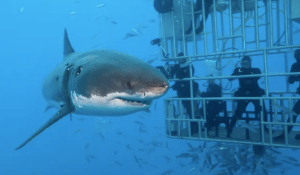
October 23, 2023
Covering a homicide trial as a journalist through the eyes of a crime writer
As I write this, I’m sitting on the floor outside of a courtroom as a jury deliberates somewhere in this building on the fate of a guy whose trial I’ve been covering since Oct. 2. It’s been a long time since I covered a trial — I haven’t been a news reporter since the mid-90s. I was an editor for nearly three decades after that, though, and guided a lot of trial coverage and edited a lot of trial stories.
From my observations, there are a lot of things I can say about how journalism has changed — and not for the better — when it comes to what the public reads about a trial these days. But that’s a blog post for another day. The details of this trial are also too long and complicated for me to get into here for the most part. [If you want to read about it, you can find my coverage at Manchester Ink Link. Do a search on there for Logan Clegg. Or me. There’s no paywall.] I’m writing this on a Friday, the first day of deliberations. You are reading it on Tuesday. It’s possible there’s been a verdict in between. This is written without knowing the verdict, obviously, but any verdict doesn’t have an impact on what is written here.
In brief, Djeswende and Stephen Reid, two very nice people in their 60s, were walking in the woods near their Concord, New Hampshire, apartment on April 18, 2022, when someone shot them. Their family reported them missing April 20, 2022, and their bodies were found, about 50 yards off the trail and covered by a pile of leaves and other woodland detritus on April 21, 2022. Logan Clegg, a young man with a criminal past who’d been living in the woods all winter, was arrested after police spent months figuring out who he was and tracked him down to where he was living, in a tent in Vermont, two days before he was due to get on a one-way flight to Germany.
You often hear people say “You can’t make this up! If this were a mystery novel no one would believe it!” My response is always that people who say that must not read many mystery novels. This crime would make a good one, with a lot of details and elements that are perfect for setting up a real mystery. In real life, though, that doesn’t always make for the perfect trial and conclusion.
I spent nearly 40 years as a journalist. I’ve spent the past 10 or so as a mystery novelist, too. It’s interesting how the two interesected and gave me perspective. I think my mystery writer mind definitely helped the journalist one. But it also helped frustrate it. There’s so much you can say in a work of fiction to get bigger truths across that you can’t say in a news article.
Before we get to the bigger truths, there were definitely little things that would play out differently in a mystery novel. An example: Someone — presumably the killer or killers — poured baking soda on top of the debris piled on the Reids’ bodies. This was likely an attempt to mask any odors [pro tip: it wouldn’t have worked]. It rained heavily the night after they were shot, so it’s likely it was done sometime closer to when they were found three days later, or it would’ve dissolved in the rain. In a mystery novel, this would’ve been a signfificant clue. In real life, it was just another thing that came up and didn’t have a lot of signficance.
Another instance was a surreal afternoon the same day as opening statements. Though I did write about it in my article, my head kept playing with how it would work as a scene in a book. How often, as a fiction writer, does someone get a chance to participate in something like this?
Clegg, the judge, a bunch of cops and the media took a trip to the trail in the woods where the shootings happened and walked it. The only time I’ve ever been on one of those was nearly 40 years ago, and it wasn’t a hike on a trail, it was a visit to a meadow. That time, the defendant wore jailhouse orange and was shackled. This time Clegg, in his trial clothes of blue shirt and black pants, and carrying a water bottle on an unseasonably hot day, could’ve been anyone. One of his attorneys stuck by his side, and law enforcement was obvoiusly there to keep an eye on him, but they didn’t stand right next to him. At some points, I found myself next to him, but moved away. It’s not that I didn’t feel safe, I just didn’t want to invade his space or get yelled at by the court clerk. Weeks later, it occurs to me that’s the only time the jury got to see him as a regular person.

Logan Clegg looks up at the trees during a site visit during his trial on Oct. 3. One of his defense attorneys, Mariana Dominguez, accompanies him. Geoff Forester photo
Big picture, this is a case with a boatload of reasonable doubt. The only thing that ties the defendant to the crime — possibly — is a pair of bullet casings that mysteriously turned up near the shooting scene a month after it happened. Yes, the shooting was in the woods, where there were a lot of “leaves and sticks” as everyone kept saying. But sniffer dogs, metal detectors and investigators combing through all that detritus didn’t turn them up in the weeks before they were found.
Then, suddenly, an assistant attorney general, visiting the crime scene for the first time, was kind of just looking around, looked down, and in a Hercule Poirot moment, said, “Hello! What is this?!” At least that’s how I picture it. What he really said was something like, “Hey Wade [one of the investigators], you wanna take a look at this!”
Months later, when Logan Clegg was arrested, he was in possession of a gun that, according to the state ballistics effort, shot bullets that matched those casings.
During the trial, Wade Brown, the detective, demonstrated that one of the “bullet casings” could also be seen if you zoomed in deeply on a photo the FBI took from a distance of the general scene on May 10, 2022, ten days before the casings were found. Then, on one of the last days of the trial, while the defense was presenting its case, a Concord police detective, apparently watching the trial on streaming while also going through photos from the day after the bodies were found, saw what he also believed was the bullet casing.
The whole thing was designed for a novel or TV. Last minute surprise evidence! This “discovery” came right before the defense was going to call a forensic digital photo analyst to testify. The state had earlier fought against him being allowed to be used as an expert, but that motion never got traction after the judge said that the state really couldn’t make much of a case against the guy, who was heavily credentialed [my words, not the judge’s], when they were using cops with no experience in forensic photo analysis to say there were casings in photos.
In a brief, but dramatic, hearing with the jury out of the room, the defense made a case that the April 22 photo shouldn’t be allowed. They were right, in my view. The judge thought differently. He allowed it. The defense, despite their obvious unhappiness in the moment, then put on two days of testimony that decimated the prosecution’s case for the bullet casings having been there before May 20.
In a book or a TV show that would have been a defining moment in the trial. For anyone paying attention, it should’ve been, too. It was a riveting display of lawyers turning on a dime and putting on a pitch-perfect defense to close out their case.
Their forensic photo analyst didn’t spend a lot of time on the April 22 photo, since he’d only seen it an hour before he testified. He spent a lot of time, though, comparing the May 20 photo of the bullet casings after the assistant attorney general found them to the May 10 FBI zoomed-in photo. The expert concluded convincingly that it wasn’t a casing at all in the FBI photo, or the April 22 one.
The defense the next morning put a Fish and Game officer on the stand whose ballistics sniffer dog Cora had searched the area April 22, 2022, and hadn’t found a bullet casing. She is trained to find anything with gunpowder on it, and she did find a bullet fragment that was definitely related to the case [more on this later].
Then they put on the cop who “saw” the casing in the April 22, 2022, photo the day before. Defense attorney Caroline Smith didn’t spend any time on the photo, but for more than an hour walked the cop, who seemed eager to please, through all of his searches of that area, including the exact spot where the two casings were later found, in the days and weeks after the shootings. Then they put on another cop, a little less eager to please, who’d also searched the area extensively, but didn’t find a bullet casing. Or two. This guy had also put up a game camera on April 23, 2022, that would’ve caught anyone planting those casings in the weeks following, but it just never seemed to work or collect any images, even though they tried to fix it at some point. Anyone writing a mystery novel could’ve had a field day with that.
Of course, this was real life. There wasn’t enough information about the malfunctioning game camera in testimony for the jury or anyone else to determine if it was really malfunctioning, and the investigators just didn’t feel like it was important enough to fix [they’d been hoping the shooter would return to the area], or if there was something more hinky involved. In my mind, you ‘d think they’d want to put one up that they were sure worked. Just saying.
In the end, the excellent defense performance was probably lost on everyone but the lawyers in the room and the one journalist (me!) who was paying attention. [That’s not a big brag from my massive ego, BTW — the only other print/digital journalist in the courtroom left before the motion hearing on the April 22 photo. She read a book during most of the defense case following it. Other reporters, I assume, watched on streaming, since they had articles every day. I didn’t read them, but from what little I saw they seemed to miss a lot. This isn’t to blow my own horn — it doesn’t take any special talent or skill to sit on your ass from 9 a.m. to 4 p.m., pay attention and take notes. Like any decent writing, it’s just hard work, tenacity and critical thinking skills. I’ll let you draw whatever conclusions you will.]
Maybe the casings were there all along. I don’t think they were. As a mystery writer, though, I’m thinking, who would plant them? The police? The only problem is that a month after the shootings, they still had no leads. They didn’t know that months later they’d arrest someone with a Glock 9mm pistol and Sig Sauer 9mm bullets that matched the casings. They did find more casings from a Glock, elsewhere in the woods, but they hadn’t found anything like that in May. The one bullet and fragments they were able to retrieve from the victims and the scene when the bodies were found weren’t in good enough shape to determine what kind they were.
My mystery writer theory was that someone, maybe not even related to the case, had picked up the casings at some point. Either after the shootings or from the Clegg’s tent site where police later found 18 casings in August. The person, either to be helpful or to be an asshole, planted them at the site. In the end, making sure a working game camera was installed would’ve helped the police tremendously if the casings hadn’t been planted. It sure wouldn’t have helped if they had though, since they were the only slim piece of evidence tying Logan Clegg to the shootings.
Of course, I didn’t fall off the turnip truck yesterday. If investigators had known what kind of gun was used, you bet your ass I’d think the police could’ve planted the casings. I know that’s not a popular opinion, but we’ve seen it time and time again in wrongful convictions. I’m not saying all police plant evidence. Of course not. But that doesn’t mean some of them, when they’re having trouble making a case, don’t. I read an awesome book by Lawrence O’Donnell, DEADLY FORCE, about his father’s involvement as a laywer in a race-based case in Boston decades ago, and the cops actually had a gun they carried around to plant at scenes of shootings. You can make this stuff up in a mystery novel, but yeah, it happens in real life, too. People just want to believe it’s still fiction.
The presumption of guiltIf this were a mystery novel and not real life, Clegg would be the ultimate red herring. A guy who did everyting wrong and was definitely in the wrong place at the wrong time. In real life, red herrings sometimes get convicted. Someone asked me last week, “Well, if he didn’t do it, who did?” If he didn’t do it, we’ll likely never know who did. Once police focused on the mysterious guy in the woods, the guy who gave them a false name when they stumbled upon him while they were looking for the Reids, that’s where the investigation went.
The benefit of a mystery novel over real life is that the writer must put other possible suspects in, or it’s not fair play with the reader. Readers know that the most obvious suspect usually isn’t the killer, because the author is making him an obvious suspect. That’s part of writing a suspenseful novel. You guys all know the drill.
In real life, though, the obvious suspect is usually the one who is arrested and convicted. Prosecutors come up with a theory, the evidence that best fits that theory is what the jury gets to hear.
Which brings me to another unpopular observation. While we make a big deal out of “innocent until proven guilty,” and the jury vows to go by that presumption, the whole nature of the courtroom, at least the one I’ve spent October in, supports a presumption of guilt.
The family of the Reids, who’ve undergone one of the worst things a family can endure, sits feet from the jury. At some point in the early days of the trial someone put a box of Kleenex in a prominent spot on the railing in front of them and it’s been there ever since. No one, that I’ve seen, has used it, but it signals to the jury — again, feet away — these people have a lot to cry about. They do, yes. But it’s just one little prop in the many ways the line between the tragic circumstances and presumption of innocence blurs. The message is that the man who made these people suffer is sitting right over there. Jurors, do you really want to cause them more pain by finding him not guilty?
Of course, the prosecutors believe the defendant is guilty, or they wouldn’t be going through this. But the courtroom setup and atmosphere is clearly us vs. them. You’re either on the prosecution side — he’s guilty! — or you’re against the family. The family is tied inexorably to the prosecution. They are accompanied by a victim advocate who works for the attorney general’s office. They sit right behind the prosecution table every single day. Several law enforcement prosecution witnesses nodded to both as they walked by after their testimony.
I’m not blaming the family at all — they’ve suffered an uncountable loss, one that’s theirs to endure for the rest of their lives. But a message is clear from day one that makes it hard for a jury to separate that from the fact that if they vote to acquit, they’re hurting these people further.
The prosecutors, too, sit feet away from the jury. During the defense case last week, I saw them on occasion whisper and smile, sometimes chuckling, with each other during the defense’s direct testimony. The message to the jury? This isn’t important to us. We aren’t worried about this. You shouldn’t be either.
As a journalist, I sit on the defense side, mostly because there’s more room. Partly because I’m neutral, and since we have to pick a side, I’m going to pick presume innocence. But it’s also easier to see the jury, defendent and both sets of lawyers from that vantage point. During testimony I scan the room — the lawyers, the family, the defendant — for reactions. I didn’t see the defense, who were in my line of site to the witness stand, laugh or smile once during the two weeks of the prosecution case.
My vantage point also means I spent three weeks sitting a few rows behing Logan Clegg, looking at his painfully thin shoulders and shoulder blades, outlined by the blue shirt, then later a gray sweater, that he wore every day. At one point, one of his lawyers straightened his inside-out collar. I wondered how often in his life someone had taken even that little bit of care with him. It wasn’t part of the theater of the courtroom. The jury’s eyes were on the witness box and their vantage point isn’t one where the gesture would’ve been obvious. The jury that is considering whether to send him to prison for much of the rest of his life isn’t in a spot where they can see him as a person, the way they see the victims’ family sitting just feet away.
Telling a bigger truth in fictionThe opinions that I’ve written about here aren’t anything that I’ve put in a news story, of course. But they are things I can use as a mystery writer to tell a bigger truth. Anyone who’s read my Bernadette O’Dea mystery series knows that I’m not always easy on the cops, [except, of course, the excellent Redimere, Maine, police chief and some members of that department]. There’s a reason for that. In my long experience as a journalist, and also with six decades as a human being under my belt, I’ve seen how people are willing to take the police narrative for granted, when it’s not always the full story, or the accurate story. Police affadavits are the first, and often only, information the public has about the evidence in a case. Affadavits are used to get an arrest warrant, but that doesn’t mean they’re always accurate or complete. The investigators’ story is then the one told in the courtroom. In many cases [not necessarily this one], the police cultivate the victims’ families during the investigation, convincing them that the person they think is a suspect is the one who did it long before he or she is charged. Even sometimes when the person never is charged.
I was bothered when another reporter in the courtroom, in coversations with me, made references to “when Clegg” did this or that, like “poured baking soda on the pile,” rather than when “the killer” did. It shows that even some journalists covering a trial don’t take presumption of innocence seriously.
Very good dogs get their dueDuring testimony in this trial, the police fudged things in little ways. I had to laugh at one of the fudges, because it’s something that my sister Rebecca and I discuss on our podcast Crime & Stuff a lot: They never, ever want to give sniffer dogs credit. I mentioned this to another reporter as it happened, as she insisted everyone on the stand always tells the complete truth. Um, no. [Some other blog post maybe I’ll talk about testilying.]
In closing arguments, defense attorney Mariana Dominguez said that, in this case, police didn’t give Cora the sniffer dog credit for finding the bullet fragment at the crime scene the day after the bodies were found, because she also never found those crazy elusive shell casings. If police gave Cora credit for finding the bullet fragment, then the jury would realize she was also capable of finding a casing if it were there. On the stand, Det. Wade Brown credited another detective — the same guy who later “saw” the shell casing in the April 22 photo — with finding the bullet fragment. Just so you know, Cora is the one who found the bullet fragment. The detective saw it after she alerted to it.
“Cora is a good dog,” Dominguez said. Yes she was, a very good dog. So was Oakley, the dog who found the Reids’ bodies. He also didn’t get credit during Concord Police Department testimony, despite defense prodding.
As a newspaper reporter and editor, I always stressed that if there’s a dog in the story, you must put the name and breed in the article if at all possible. If a dog does something good, if it does something bad, if it dies in a fire, whatever, readers want to know. Same goes for cats, by the way, though they play less of a role in news stories and criminal cases.
There were a lot of dogs in this case to write about. Two of them were Bodi and Coriander, the poodle mix and mutt that belong to Nan Nutt, who was walking them on the trail April 18, 2022, when the Reids passed her on their way into the woods. She heard gunshots a few minutes later, then five minutes after that crossed paths with a guy who was very likely Clegg. Nan Nutt is her real name, and she would be a great character in a book. A retired immunology research scientist with two Ph.D.s, she would not concede to the police that the man she saw was Clegg, and was not asked to identify him in court. He could’ve been, but she didn’t get a good enough look, as they passed, to say for sure. Good for her for being precise and not falling to police pressure, as so many witnesses do, to say what they want the witness to say. [Of course, the local newspaper’s headline said something like “Witness testfies about seeing Clegg in woods.”]
Cora, Oakley, another sniffer dog, Winnie, and even Bodi and Coriander played a part in this case. In my articles, I gave them some ink. In a mystery novel, they would’ve gotten a lot more. Good dogs, all. Very good dogs.
Courtoom scenes in mystery novels? MehIn general, I don’t have courtroom scenes in my novels. I usually feel a little “ugh, not this” when they come up in books or true crime docs. I feel like the information has already been discussed, so it’s going to slow down the narrative. That, of course, isn’t to knock any of my fellow Maine crime writers who DO have courtroom scenes. I’m sure they’re awesome and great reading.
But some courttroom scene information that I thought would be helpful to a mystery, besides the stuff already mentioned, came to mind as I sat through the trial. One was that much of a defense’s case is made through cross examination of the state’s witnesses. This was particularly true in this trial, where the prosecution witnesses took up about two weeks of the testimony and the defense took up about two days, much of it dealing with the surprise April 22 “shell casing” photo.
I’m not sure most people realize that. People are always so shocked when the defense doesn’t call a witness or “doesn’t put on a case.” In this case, some of the prosecution witnesses ended up being better for the defense — like Clegg’s supervisor at a grocery store in Vermont who, under cross examination by the defense, said she cried when he gave his notice. She said he was a hard worker and good at his job.
In a book, I’d be able to critique defense attorney Mariana Dominguez’ passionate and perfectly written closing, which hit every note. I’d critique prosecutor Joshua Speicher’s, too, which as a writer, editor and person listiening for someone to make a good case, I found hamhanded and trite. But as my youngest sister sometimes points out, not everyone’s an English major. Just as she and I can’t agree on the quality of Dan Brown’s books, or the fact that people are using prepositions inaccurately much more than they used to is troubling, the jury may have listened to the prosecution’s closing from a totally different point of view than I did. He certainly made a case that the Reids were good people. He certainly did a lot of pointing at Clegg, calling him a murderer. It didn’t erase any reasonable doubt I had that Clegg shot the Reids.

In the first day of testimony in the Logan Clegg trial, Oct. 4, Susan Forey, Stephen Reid’s sister, testifies about reporting her brother and his wife, Djeswende, missing. Photo by Geoff Forester
Speicher started his closing argument with the same photo that opened testimony Oct. 4 — one of Djeswende and Stephen Reid at a birthday celebration for Stephen. It’s a poignant reminder that two people were were killed. The first witness to testify weeks before was Stephen Reid’s sister, Susan Forey, a former New Hampshire State Police lieutenant, who’d reported the couple missing.
Speicher in his closing, pointed to Clegg and shouted “murdered by the defendant!”
The defense contends that confirmation bias led police to focus on one guy, the strange guy in the woods who drank a lot of Mountain Dew and took off out of state the day after the bodies were found. During the voir dire portion of jury selection on Oct. 2, after a jury pool of nearly 200 was pared down to 24, Dominguez asked the group if anyone knew what confirmation bias was. One guy raised his hand. He didn’t make the final cut. I thought right then that it was going to be tough to sell a confirmation bias case to a jury that until Oct. 2 had never heard the term.
Out of that pared-down pool of 24, the one Black person out of the original near-200, also didn’t make the cut. The courtroom isn’t privy to the final strikes by both sides, so we don’t know which side struck the guy who knew what confirmation bias is, or the Black guy. My guess is that the prosecution struck both. Confrimation bias guy was easy — the defense had made clear that was a big part of their case. The Black guy? My guess is that the prosecution didn’t want the one person most likely to question police and their techniques. On the other hand, it’s possible the defense thought he’d sympathize with the Reids, because Djeswende was Black. And, as we know, the more the jury sympathizes with the victims, the harder it is for them to consider the innocence of the defendant. Or even whether the prosecution has made its case. On the same note, in the final 24 there was a woman who looked to be in her 60s, the same age as Djeswende, who seemed very nice and friendly and kind, from the interactions and body language I saw over the course of that day. She was also struck. She was Asian, not Black, but I thought the defense might think she’d remind fellow jurors of Djewsende. If she were on the jury it could, again make it harder for them to find Logan Clegg not guilty.
We’ll never know. But the way juries are narrowed down to 12 (in this case, there were four alternates as well), also filters out those who can see the nuances of a case. Almost anyone who seemed to demonstrate critical thinking skills was struck. If you were trying the case, you wouldn’t want someone who’d question the evidence too much. Who’d wonder too much about the shell casings or baking soda. Or the red herrings. Or realize how investigators can get it wrong. Or wonder what the lawyers were keeping from them. I was on a grand jury in the mid-1990s and it sucked. [Another blog post for another day]. I don’t remember any kind of thorough voir dire, though. I’m pretty sure nowadays, this mystery writer will never get picked for a jury. I used to think I wanted to be. I’m not so sure I do anymore.
Sorry this is so rambling and long. That’s what happens when you are sitting on a floor outside a courtroom writing on a laptop after sitting through three weeks of complex testimony in a murder trial and thinking like both a journalist and a mystery writer. Most of my journalism on this is done, except for the article announcing the verdict.
Is my mystery writer work done? Not really. I am not going to write a book about this trial or case. I certainly don’t expect to start including courtroom scenes, at least not anything but very short ones, in the books I do write. Ugh. It exhausts me just to think about it. But don’t be surprised if my near-month covering this trial inspires some stuff in upcoming books. My next Bernadette O’Dea book, DYING FOR NEWS, is being written even as we speak and is due out in the spring. The one I’ve been working on for a few years, working title THE MOST DANGEROUS MONTH, has more lawyer-courthouse (though not much courtroom) stuff in it. Both, I think will benefit from my strange October. Ooo, that sounds like a good title for some other future book. Dibs!
[Full disclosure: In podcast episodes months before I ever knew I would cover this trial, I at times posited that I thought Clegg was guilty. I am not covering stories in my podcast as a journalist. But, as a working journalist covering the trial, that initial opinion had no influence on my reporting, which was about the testimony and case in front of me. Now that it’s over? I have no clue if he guilty or not, but believe there’s plenty of reasonable doubt].
Books, Audiobooks, & Netflix by Matt Cost
There are so many formats of reading in the current world. I am presently reading Robbed Blind by Gerry Boyle, listening to Win by Harlan Coben on audiobook, and watching Longmire on Netflix. Does this count as reading three books at the same time?
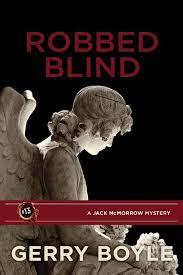
You can probably guess from this list that mystery/thriller is my genre of choice, but even within that genre, what a wide range of literary differences. An investigative journalist in central Maine to an ultra-wealthy vigilante for justice in New York City to a rural sheriff’s department in northern Wyoming. Wow.
I have wondered where my love of the mystery/thriller genre has come from and have come to a fairly simple solution that is rarely mentioned. Mysteries and thrillers are merely fiction books where something happens. There is action, intrigue, and suspense. The plot is propelled forward and brings the reader (and the writer) along with it.
In Robbed Blind, Gerry Boyle is masterfully weaving together the several different threads that keeps the reader on his or her toes. The Zombie Bandit, the murder of a kind and religious man, and a militia training in the woods of central Maine. The characters are well-developed and fleshed out and the plot drives everything forward in the masterful way that Boyle is so adept at.
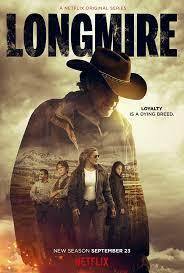
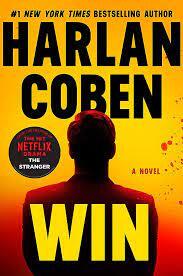
Harlan Coben is hit or miss for me. I love or hate his books. Win is on the winning side of that equation. The action is fast and furious, and the mystery is elusive and engaging. It also most likely helps that the protagonist is one of the ultra-wealthy seeking justice in a world that cannot always provide it by legal means. Why does that help? Well, I have just finished the first edits on my most recent work, The Not So Merry Adventures of Max Creed, a modern-day Robin Hood tale that mirrors Coben’s storyline in many ways (For the record, I was long done my first draft before beginning Win).

An intriguing facet of watching Longmire is I haven’t read any of Craig Johnson books and therefore have no idea how accurate the series is and whether or not it is a true representation of him as a writer. For those of you who don’t know, Walt Longmire is the dedicated and unflappable sheriff of Absaroka County, Wyoming. He is widowed, emotionally damaged, but deeply principled. I will have to say that the series is keeping my interest and allowing me to slog through my rower and treadmill time.
Do you consider listening to an audiobook or watching a Netflix series to be reading? Just wondering. Write on.
About the Author
Matt Cost was a history major at Trinity College. He owned a mystery bookstore, a video store, and a gym, before serving a ten-year sentence as a junior high school teacher. In 2014 he was released and began writing. And that’s what he does. He writes histories and mysteries.
Cost has published five books in the Mainely Mystery series, with the fifth, Mainely Wicked, just released in August of 2023. He has also published four books in the Clay Wolfe Trap series, with the fifth, Pirate Trap, due out in December of 2023.
For historical novels, Cost has published At Every Hazard and its sequel, Love in a Time of Hate, as well as I am Cuba. In April of 2023, Cost combined his love of histories and mysteries into a historical PI mystery set in 1923 Brooklyn, Velma Gone Awry. City Gone Askew will follow in April of 2024.
Cost now lives in Brunswick, Maine, with his wife, Harper. There are four grown children: Brittany, Pearson, Miranda, and Ryan. A chocolate Lab and a basset hound round out the mix. He now spends his days at the computer, writing.
October 20, 2023
Weekend Update: October 21-22, 2023
 Next week at Maine Crime Writers there will be a posts by Matt Cost (Monday), Maureen Milliken (Tuesday), Charlene D’Avanzo (Thursday), and Vaughn Hardacker (Friday).
Next week at Maine Crime Writers there will be a posts by Matt Cost (Monday), Maureen Milliken (Tuesday), Charlene D’Avanzo (Thursday), and Vaughn Hardacker (Friday).
In the news department, here’s what’s happening with some of us who blog regularly at Maine Crime Writers:
Matt Cost will be in Portsmouth, NH, on Sunday, October 22nd, reading from his work along with 12 other authors. These include Maine Crime Writers Kate Flora, Dick Cass, Brenda Buchanan, and Barbara Ross. The event will be from 4:00 to 6:30 p.m. at the Portsmouth Book & Bar at 40 Pleasant St, Portsmouth, NH 03801.

An invitation to readers of this blog: Do you have news relating to Maine, Crime, or Writing? We’d love to hear from you. Just comment below to share.
And a reminder: If your library, school, or organization is looking for a speaker, we are often available to talk about the writing process, research, where we get our ideas, and other mysteries of the business, along with the very popular “Making a Mystery” with audience participation, and “Casting Call: How We Staff Our Mysteries.” We also do programs on Zoom. Contact Kate Flora
Lea Wait's Blog
- Lea Wait's profile
- 509 followers



